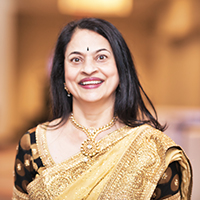Anuradha M Agarwal
Massachusetts Institute of Technology, USAFor pioneering contributions to integrated mid-infrared photonic sensing, detection, imaging, and leadership in training the next generation in photonics manufacturing.

Anuradha Agarwal grew up in India, near the Arabian Sea. As a child, she had a curious mind, wondering what made the waves crash onto the rocks at night and recede during the day revealing a beach full of seashells. When she was eight she distinctly remembers watching the Apollo 11 moon landing event, on a small black and white TV at her friend’s house. Neil Armstrong’s quote, “One small step for man, one giant leap for mankind,” profoundly resonated with her. Later as she grew more interested in learning how things worked, she was fascinated by her mother’s sewing machine and took it apart one day to gain insight. For each of these memories of trying to figure things out, Anuradha remembers her parents saying, “You’ll learn about that in science when you’re older,” or “I’m glad you are curious; I hope you’ve learned something.” It was always apparent to her that science held the answers, and it was an easy choice to pursue it as a career.
She began her career in electrical engineering, and today her focus is on developing new materials and processes for on-chip photonic sensing and imaging. She started down this particular path from her work with Professor Lionel Kimerling at the Massachusetts Institute of Technology, USA, where she did her postdoctoral work and made the transition from electrical engineering to photonics. She worked with him on telecom and datacomm applications, attempting to create polycrystalline silicon waveguides. As she continued this work, she wanted to explore other wavelengths beyond telecom. However, on-chip light manipulation for each wavelength (or color) of light comes with its own set of unique and interesting challenges. For example, the commonly used silicon-on-silicon dioxide waveguide is not suitable for light transmission beyond 4 microns. Her main goal is to build an on-chip sensor system. Anuradha is enthusiastic about her work and comments, “The number one thing I can say for sure is that the last 30 years of my career have been nothing but fun.”
She is particularly proud of two of her early accomplishments in integrated photonics: demonstrating low-loss polycrystalline silicon waveguides on-chip, and developing a technique to efficiently couple a fiber to a chip using graded index layers on the chip. In the first example, she recalls that the group started with amorphous silicon material, with a few small grains. Amorphous silicon was ill-suited for the task of efficient light transmission due to the presence of lossy dangling bonds, so she and her team annealed the amorphous silicon to polycrystalline material and then passivated the dangling bonds with hydrogen, achieving the goal of light transmission. She shares, “[Eventually], we saw a couple of orders of magnitude improvement, but we went beyond that, and now polycrystalline silicon waveguides are commonplace.” Her other proudest work on coupling fibers to chips led to “graded-index coupling,” which is widely used today.
As a child and early in her career, she was encouraged to pursue her interests. Her mother, a botanist by training, fostered Anuradha’s innate curiosity by teaching her about plants and the natural world around her. Her father was a documentary film maker and professor who worked for the government, so the family frequently moved to new cities in India. With each move came a new school, language, and surroundings. This experience could have been highly disruptive for her, but she remembers how her parents handled the situation very well, building resiliency instead. She says they always framed the next move as an excellent learning opportunity and demonstrated enthusiasm for learning new cultures. Today she encourages curiosity and enthusiasm in young people she encounters.
Later, when she was a young postdoctoral fellow at MIT, Professor Kimerling was a tremendous mentor and supporter of her research, providing challenges that became excellent learning opportunities. In her current role as a PI, life has come full circle as she now gives back to her students. Her advice for budding scientists is “in your work try to learn methods that will help you uncover the marvels of nature, either through a science project or an internship.”
Photo Credit: Anuradha M Agarwal
Profile written by Samantha Hornback
